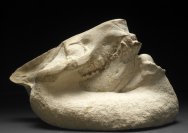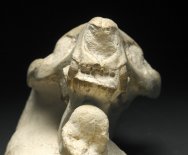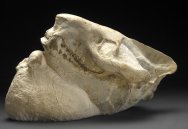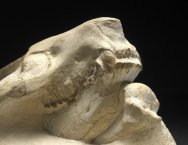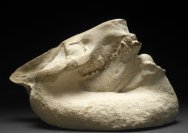 Description:
Believe me; you wouldn’t want to have tangled with this growling,
nasty little beast when it roamed the grasslands and plains of ancient
America. The skull is solid and heavy in the hand. It most certainly
would be a centerpiece for a private collection, or museum display
grade fossil. Description:
Believe me; you wouldn’t want to have tangled with this growling,
nasty little beast when it roamed the grasslands and plains of ancient
America. The skull is solid and heavy in the hand. It most certainly
would be a centerpiece for a private collection, or museum display
grade fossil.
The
Eporeodon skull has approximately 5% restoration. The crest, and
enamel repair on part of upper canines and about half of incisors
were repaired or reconstructed. The restoration work is well within
the expected norms for specimens of this showcase quality. The front
of the jaw rests comfortably on what appears to be the top of a
thighbone.
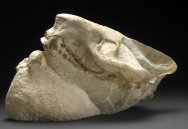 The
badlands of the western US are particularly rich in mammal fossils
from the late Eocene to Miocene. The Brule Formation is exposed
over a huge area including Nebraska, North and South Dakota, Wyoming,
and Colorado, and yields abundant fossils as layers are eroded.
This diverse group of stocky prehistoric mammals grazed amid the
grasslands, prairies or savannas of North and Central America throughout
much of the Cenozoic era. The
badlands of the western US are particularly rich in mammal fossils
from the late Eocene to Miocene. The Brule Formation is exposed
over a huge area including Nebraska, North and South Dakota, Wyoming,
and Colorado, and yields abundant fossils as layers are eroded.
This diverse group of stocky prehistoric mammals grazed amid the
grasslands, prairies or savannas of North and Central America throughout
much of the Cenozoic era.
The
Oreodonta is an extinct mammal group distantly related to pigs,
hogs, camels,  hippopotamuses,
and the pig-like peccaries. Over 50 species of Oreodonta have been
described. They first appeared some 50 million years ago during
the warm Eocene and were widely prevalent during the Oligocene in
the grasslands, prairies or savannas of what is now the North American
badlands. The Oreodonts mysteriously disappeared some four million
years ago during the Pliocene. Today, fossil jaws and teeth of the
Oreodonta are commonly found in the White River badlands in South
Dakota, Nebraska, and Wyoming. Oreodonts have a unique place in
the evolution of ruminant teeth and with peccary-like attributes.
Oreodonts are Artiodactyls, even toed ungulates, sometimes called
a cross between a pig and a sheep. Note that they have both large
canine front teeth, but also molars for chewing. hippopotamuses,
and the pig-like peccaries. Over 50 species of Oreodonta have been
described. They first appeared some 50 million years ago during
the warm Eocene and were widely prevalent during the Oligocene in
the grasslands, prairies or savannas of what is now the North American
badlands. The Oreodonts mysteriously disappeared some four million
years ago during the Pliocene. Today, fossil jaws and teeth of the
Oreodonta are commonly found in the White River badlands in South
Dakota, Nebraska, and Wyoming. Oreodonts have a unique place in
the evolution of ruminant teeth and with peccary-like attributes.
Oreodonts are Artiodactyls, even toed ungulates, sometimes called
a cross between a pig and a sheep. Note that they have both large
canine front teeth, but also molars for chewing.
|



